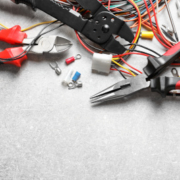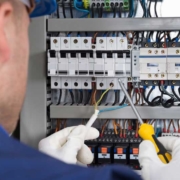What are the most common electrical terms?
Electrical terminology can be daunting and confusing. All those electrical words and abbreviations can be confusing even for us as an electrical installation company.
In this article, we’ll look at some commonly used electrical words and electrical terms.
In some sections, we have added links to explain those electrical definitions further.
Units Of Measurement
Watt
A watt is a unit of power that measures how much energy an appliance or device uses. For example, a 100-watt light bulb uses more energy than a 60-watt light bulb.
Amp
An amp (or ampere) is a unit of measurement for electric current. It measures the amount of charge flowing through a conductor, such as a wire.
Volt
A volt is a unit of measurement for electric potential difference. It measures the difference in electric potential between two points.
Ohms
An ohm is a unit of measurement for electrical resistance. It measures the resistance of a material to the flow of electric current.
Kilowatt (kW)
A unit for measuring electrical energy
Kilowatt Hour (kWh)
Within one house how much kilowatt of electrical energy is produced or used in
Common Electrical Terms (Safety Devices)
Circuit breaker
A circuit breaker is a safety device that protects an electrical circuit from damage caused by overload or short circuit.
GFCI
A ground fault circuit interrupter (GFCI) is a safety device that protects against electrical shock. It works by sensing any imbalance in the current flowing through the circuit and instantly shutting off the power to prevent shock.
Fuse
A fuse is a safety device that protects an electrical circuit from damage caused by overload or short circuit. It consists of a thin strip of metal that melts and breaks the circuit when too much current flows through it.
MCB
An MCB is a miniature circuit breaker forming part of the electrical fuse board. The MCBs are at the end of each electrical wiring circuit – “What is an MCB?”
RCD
An RCD (or residual current device) is a safety device that protects against electrical shock. It works by sensing any imbalance in the current flowing through the circuit and instantly shutting off the power to prevent shock. – “What is an RCD?”
Surge protector
A surge protector protects electrical equipment against damage caused by electrical surges. It diverts the surge of electricity away from your devices and into the ground, preventing damage. Power surges are likely to happen when an abrupt increase in electricity goes through the power lines.
Electrical Testing
PAT Test
A PAT test (or portable appliance test) is carried out on electrical appliances and equipment to ensure that they are safe to use. The test involves checking the appliance for any signs of damage, testing the insulation, and testing the cord for any signs of wear or tear. It is recommended that you have your electrical appliances tested every 12 months. This will help ensure they are safe and not a fire hazard. – “What is a PAT Test?”
EICR Test
An EICR (or electrical installation condition report) is a test that is carried out on the electrical installation in your home or business. The test checks for any signs of damage, faults, or wear and tear. It is recommended that you have your electrical installation tested every 5 years. This will help to ensure that it is safe to use and is not a fire hazard. – “What is an EICR Report”
Common Electrical Words
Alternating current (AC)
When electrical currents at regular intervals reverse direction
Battery
Electric cells that are singular or grouped and produce a direct electric current (DC).
Electrical Blackout
This is when there is a total loss of power within your building, grid or area
Brownout
It is similar to a blackout but only temporarily
Capacitance
How much can a component store an electrical charge?
Electrical Circuit
This is the path that the electrical current follows.
Conductor
A material or substance that permits electrons, or electrical current, to move through it.
Current
Describes the electrical movement through a conductor.
Direct Current (DC)
This is an electrical current flowing in a single direction
Electricity
Electrons flowing between two points
Electron
These are particles that are negatively charged. Electricity is produced by the flow of electrons.
Fuse
These are an electrical safety device. A fuse consists of a piece of fusible metal or metal. When this melts, it interrupts the electrical circuit. When the current exceeds a preset amperage, the fuse comes into effect.
Generator
A piece of equipment which uses diesel or similar energy to create electrical energy.
Ground
When a route to Earth is created for an electrical connection
Electrical Load
How much does an electrical device use in power terms
Megawatt
1,000,000 watts.
Meter
A tester that measures the amount of electricity moving through it.
Power
How much energy is consumed by something to do a set amount of work which is measured in watts.
Power Factor
Measured as the ratio of watts to volt-amperes to analyse the inefficient use of electrical power
Resistance
Measures how the flow of electricity is resisted through a set item of material.
Socket
A fixed electrical socket is one that something fits into, such as an electrical plug socket, light socket, or commando socket.
Spike
Increased voltage for a short period of time. Generally, this only lasts half a cycle
Substation
Main electrical buildings and facilities that serve a wide range of buildings and customers.
Surge
Increased voltage for a short duration
Switch
An electrical component that breaks or reconnects the electrical circuit within a device such as switching on and off a plug socket or light.





